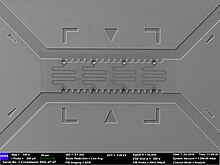Ion beam
An ion beam is a focused beam of charged particles , more precisely ions, generated by an ion source .
history
The history of ion beams begins with the study of alpha radiation by Ernest Rutherford in 1911. At Rutherford, the ion source consisted of a radium preparation , the alpha radiation of which was collimated with a lead shield for scattering experiments .
As early as 1928, the first ions were artificially accelerated with a drift tube accelerator. In the following years Cockcroft-Walton accelerators and other DC voltage accelerators were used to accelerate ion beams in research; this was the first time that a nuclear reaction triggered by artificially accelerated particles was observed in 1932. In the course of the 1930s, electron and ion optics were brought to maturity: With the help of magnetic fields, it is possible to focus an ion beam similar to a light beam and thus transport it without expanding the beam.
The knowledge gained during the Second World War in the field of microwave generation benefited the further development of the alternating field accelerator for ions (see linear accelerator , synchrotron ). Shortly after World War II, the principle of strong focusing was discovered, which became crucial for the development of high-energy ion accelerators.
generation
Today ion beams are generated in specialized ion sources . The type of source to be selected depends on the requirements for energy , state of charge , total or pulse current and ion species . For this reason, various ion sources that can be used alternately are installed at some accelerator facilities.
The ion beam is always generated in a vacuum . To do this, neutral atoms are first ionized using various techniques. The ion source also contains the first acceleration stage, which uses an electric field to determine the main direction of movement for the ions. Only after this step can one speak of an ion beam.
For some applications the output energy of an ion source is sufficient and the ion beam can be used directly. Other areas of application, especially nuclear and particle physics, require higher energies, for which the ions have to be accelerated further in a particle accelerator.
Applications in research
In research, ion beams are used in a similar way to electron beams in particle , nuclear and atomic physics . A particle accelerator is usually used with the ion source to bring the ions to the required energy.
Heavy ion beams have applications, for example, in medicine ( heavy ion therapy ) and possibly in the future for energy generation through inertial fusion .
Industrial applications
In industry, ion beams with lower energies in the energy range up to a few mega electron volts are used, especially for ion implantation , e.g. B. in semiconductor technology and in focused ion beam processes for microscopy and material processing as well as mass spectrometry ( secondary ion mass spectrometry ). Ion beams are also used for isotope analysis : In accelerator mass spectrometry , an ion beam is generated from a material of unknown isotopic composition. The composition is then determined by means of the differences in the ion-optical properties of different isotopes, so that conclusions can be drawn about the age or the origin of the material.
Higher energy ion beams are used to generate radionuclides and neutrons for medicine and material analysis.
Ion beam engines can possibly be used in space travel .
See also
Individual evidence
- ^ Stanley Humphries: Charged Particle Beams . John Wiley and Sons, 1990, ISBN 0-471-60014-8 .
- ^ Ernest Rutherford: The scattering of alpha and beta particles by matter and the structure of the atom . In: Philosophical Magazine . 21, 1911, pp. 669-688.
- ^ A b S. Y. Lee: Accelerator Physics . World Scientific, 1999, ISBN 981-02-3710-3 .
- ^ ED Courant, M. Stanley Livingston, S. Hartland Snider: The Strong-Focusing Synchrotron - A New High Energy Accelerator . In: Physical Review . 88, No. 5, August. doi : 10.1103 / PhysRev.88.1190 .
- ↑ Ian G. Brown (Ed.): The physics and technology of ion sources , 2nd ed .. edition, Wiley-VCH Verlag GmbH, 2004, ISBN 978-3-527-40410-0 , doi : 10.1002 / 3527603956 .
- ^ Robert W. Hamm, Marianne E. Hamm: The beam business: Accelerators in industry . In: Physics Today . tape 64 , no. 6 , 2011, p. 46 , doi : 10.1063 / 1.3603918 .

